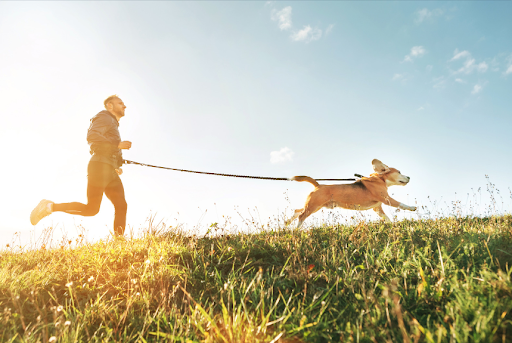The Role of Exercise In Your Dog’s Behaviour & Mental Health

Regular exercise is essential for dogs, not only to maintain their physical health but their mental health too. It can help to reduce their stress and anxiety, therefore improving their overall mood. Physical activity for dogs doesn’t have to mean hour-long walks every day either, even playing fetch, getting them to chase toys & teaching them tricks can help keep their brains and bodies active.
Let’s explore the 5 key benefits of regular exercise for your dog’s physical & mental health:
1. Keeps them fit and healthy
One of the most obvious benefits of regular exercise for your dog is improved physical health. It helps to keep your dog active and mobile, strengthening their joints and muscles. Regular walks are really important for older dogs to help reduce the risk of arthritis and stiffness. Exercise also helps keep your dog’s weight in check, therefore keeping their cardiovascular system healthy and functioning well.
2. Improve your dog’s mood
Physical activity is a great way to get rid of your dog’s excess energy. Just like with humans, exercise releases endorphins in your dog’s brain which leave them feeling happier. Regular exercise can help reduce stress, anxiety, and depression in dogs, as well as improve their overall cognitive function.
4. Helps your dog interact with others
Regular walks are a great way to socialise your dog, with both other dogs and people too. Doggy play dates are perfect for allowing your dog to interact with others and improve their social skills. This can also help to reduce feelings of isolation and loneliness that they may have.
5. Keeps your dog’s mind sharp
Just like humans, dogs also need mental stimulation to keep their minds sharp and focused. Engaging in activities that challenge their mind such as agility are great ways to improve their memory. If you haven’t got the time or money to attend regular training classes, even just exploring new walks with your dog can help with this. By exposing them to new sights, sounds, and smells, this is enough to stimulate their mind and keep them mentally active.
6. Improves your dog’s behaviour
Dogs that don’t get exercised regularly can often become bored, which can lead to them engaging in destructive behaviour such as chewing or digging. This often happens when dogs are left unattended for long periods of time while their owners are out working during the day. If you are unable to pop back home during your lunch break to take your
dog for a walk, there are lots of dog sitters/walkers who can take care of them for you. You shouldn’t leave your dog alone for really long periods, and you should always take them out for a long walk or good play session before you leave too.
Games For Your Dog
As well as taking your dog for regular walks, you should also allocate time during the day to play with them. This can be a great way to incorporate training in a fun way. As well as the basic ‘come’, ‘sit’, ‘down’, and ‘stay’ commands that you can teach your dog, here are some more fun games you can play:
· Search: put out small bags or boxes with one that contains your dog’s favourite treat or toy and leave the others empty. Ask your dog to search and find the treat/toy.
· Follow along: this is great for training young puppies. Throw a treat away from you so your puppy moves away, then when they glance in your direction praise them, jog in the other direction, and encourage them to follow. Reward them when they come to you and start the process again. This game forms the foundations of recall.
· Hide and seek: one person should distract your dog, while the other sneaks away to hide. The hider then calls out, to draw attention to themselves, and the dog is encouraged to find the hider.
· Go to place: teaching a dog to run to a mat, dog bed or crate is really useful (as well as being fun!). Start by throwing a treat onto the mat or bed, encouraging the dog to investigate. Take a few steps away from the mat, call your dog to follow you, and then throw the reward onto the mat again, encouraging your dog to find the treat. You can then slowly increase the distance and introduce a verbal cue so when your dog is about to take a step towards the mat, say ‘stay’, then once your dog reaches the mat throw the treat.
For tailored advice and training sessions, our expert team at WitsEnd is on hand. Working with people from all over the country, we have had over 2000 success stories! To book an appointment or for more information, please call us on 0116 244 2455.